Famous Ancient Artifacts – Study Artifacts From the Ancient World
What can artifacts from the ancient world teach us about our ancestors? What is the oldest human artifact ever discovered by archeologists? Ancient world artifacts are often our only link with the civilizations of prehistory and can reveal much about the lifestyle of ancient humans. In this article, we will look at the most famous ancient artifacts and how they were able to shed light on the dark and mysterious past.
Ancient World Artifacts
Historical artifacts are objects such as clothing, tools, and art that were made by human beings in the distant past. Many of the oldest artifacts were produced in a period when there was no written language, so these famous artifacts are often the only clues that we have about their way of living.
Thankfully, archeologists love to find artifacts from the ancient world, and we, therefore, have a rather comprehensive understanding of how the ancient Greeks, Romans, Egyptians, and other cultures lived.
Famous Ancient Artifacts
Throughout the centuries, archeologists have discovered thousands of historical artifacts. Yet, not all of them become world-renowned famous artifacts. Only those that have given us a clearer view of the past have reached the level of famous ancient artifacts. From the oldest human artifact to the most intriguing and insightful, here is our list of famous ancient world artifacts.
Lomekwi Stone Tools (3.3 million BCE)
| Date | 3.3 million BCE |
| Medium | Stone tool |
| Artist | Unknown |
| Location | West Turkana, Kenya |
The oldest artifacts ever discovered were tools made by primitive people from Kenya around 3.3 million years ago. Whether they are the oldest human artifacts depends on what you consider to be human. Based on the age of the historical artifacts, they were most likely created by some sort of pre-human hominins such as the Australopithecus or Kenyanthropus.
The tool crafters chose massive, heavy slabs of hard stone on purpose, rejecting smaller slabs of the same material found nearby.
Archeologists have ruled out the likelihood that the tools were formed naturally, stating that the items were visibly knapped and not the product of spontaneous rock fracture. Analysis revealed that the cores were rotated when flakes were struck off. The function of these famous artifacts is unknown, as animal bones discovered at the location show no evidence of tool use. This is the most advanced example of late Neogene innovation in the history of human evolution.
It is unknown if these oldest artifacts are connected to those created by the Homo species. It is possible that the technique was lost and subsequently rediscovered again at a later period.
Blombos Paint Studio (c. 100,000 BCE)
| Date | c. 100,000 BCE |
| Medium | Abalone shells |
| Artist | Unknown |
| Location | Blombos Cave, South Africa |
Archaeologists discovered 100,000-year-old pigment-making artifacts – the earliest proof of paint mixing – within the South African Blombos cave in 2011. Two abalone shells with ocher powder in them were discovered by archaeologists. To make a liquid concoction sticky, ancient humans would add charcoal and bone, while ochre gave it the color. Other instruments used in the production of the materials were hammerstones and grindstones.
A complete toolkit for making a colored mixture was located under, above, and to the side of each shell.
The microscopic quartz grains that had stuck to the finger had left a very faint imprint in the shell. For the period, the chemistry involved was quite complicated. The cognitive ability to find, mix, and store chemicals that improve technology or social activities is a milestone in the evolution of human consciousness.
Furthermore, it serves as an indicator of individuality: the ultimate goal of displaying anything on your walls or on yourself is to convey a message about who you are.
The Divje Babe Flute (c. 50, 000 BCE)
| Date | c. 50, 000 BCE |
| Medium | Bone |
| Artist | Unknown |
| Location | Slovenia |
The Divje Babe flute, discovered in 1995 in a cave in Slovenia, is thought to be the earliest musical instrument ever unearthed. The object is a part of a cave bear’s femur that has been perforated with spaced holes and has been dated at roughly 50,000 years old.
Researchers who refused to accept the concept of Neanderthals playing music dismissed the possibility, claiming that the perfectly spaced and beautifully etched holes were caused by an animal chewing on the bone piece.
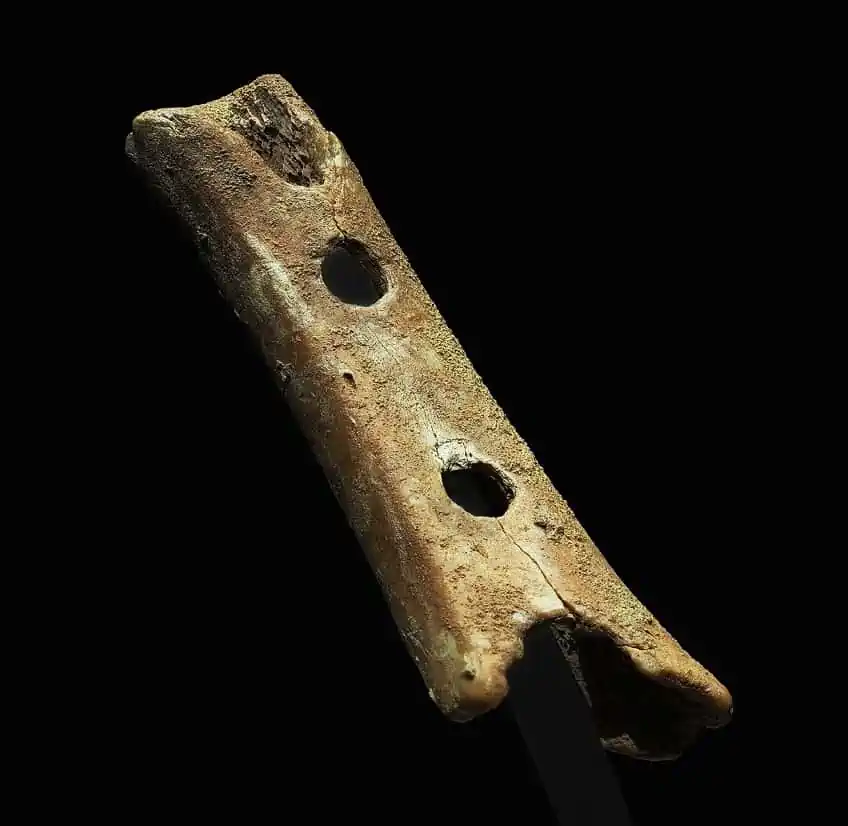
Nevertheless, as the perception of Neanderthals shifts from barbaric, uncivilized brutes to more educated people, there is a general agreement that the Divje Babe flute is indeed a musical instrument. Paleolithic researchers are particularly interested in finds possessing symbolic value and the artifacts that precede the appearance of homo sapiens in Europe receive special attention.
Babylonian World Map (c. 9th century BCE)
| Date | c. 9th century BCE |
| Medium | Clay |
| Artist | Unknown |
| Location | The British Museum, London |
This stone has cuneiform text as well as a map of Mesopotamia. Babylon is depicted in the center, while Elam, Assyria, and other locations are also mentioned. A circular canal labeled “Salt-Sea” encircles the core region. The sea’s rim is encircled by what was most likely originally eight areas, each shown by a triangle and labeled with the distance between them.
Although the cuneiform writing is incomplete, it appears that weird and mythological monsters as well as renowned heroes existed in these locations.
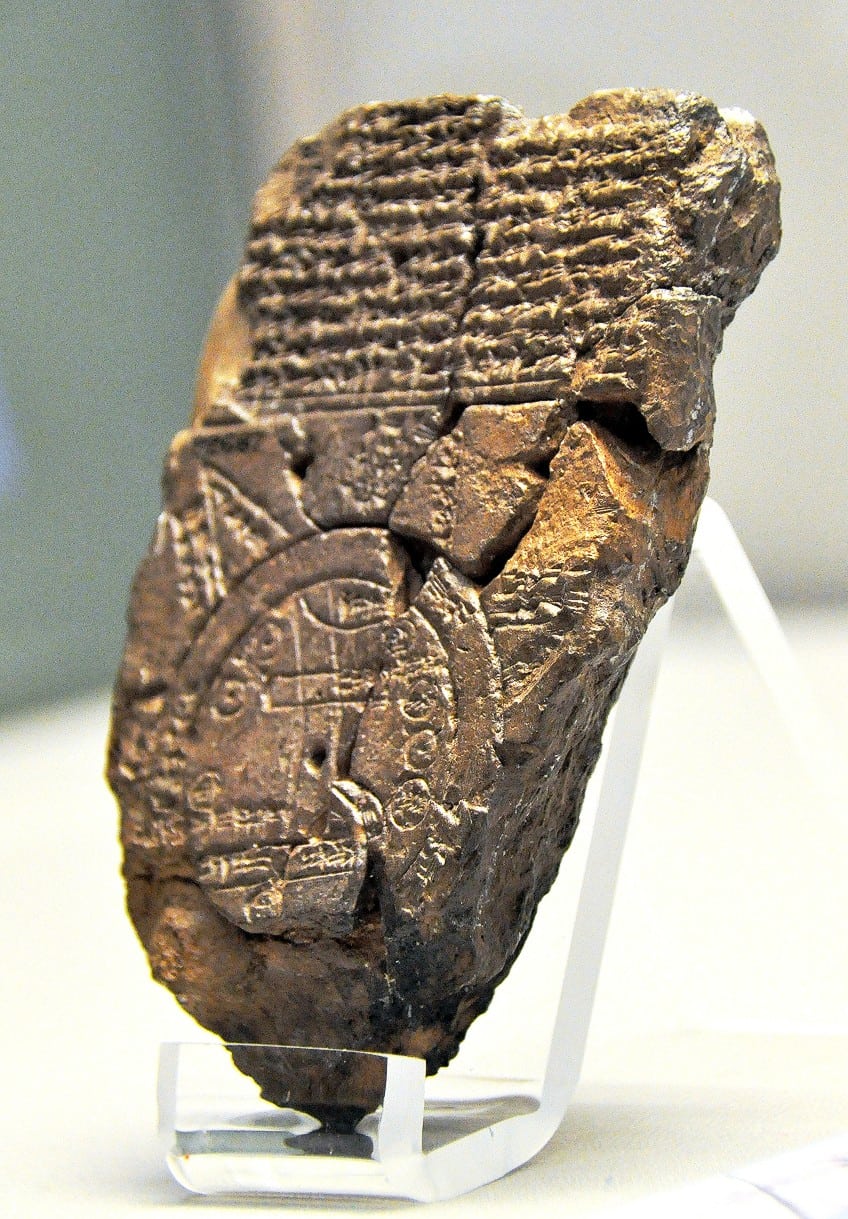
The Ubaid Lizards (c. 5,000 BCE)
| Date | C. 5,000 BCE |
| Medium | Clay |
| Artist | Unknown |
| Location | Ubaid, Iraq |
Diggers were excavating an archaeological site in Iraq in the early years of the previous century when they came across a strange finding: multiple relics portraying humanlike figures with the characteristics of a lizard, such as almond-shaped eyes, stretched heads, long, slender faces, and the nose of a reptile. Some seem to be wearing helmets and have pads on their shoulders. Other figures were discovered holding a staff, presumably as a symbol of law and authority.
Female and male sculptures were discovered in various poses, but the oddest of all is the female figures holding newborns sucking milk, with the baby similarly shown with lizard-like characteristics.
The Ubaidian civilization is an ancient Mesopotamian culture that goes back to roughly 5,000 BCE. The origins of the Ubaidians, like those of the Sumerians, are unknown. They lived in vast village communities with mud-brick buildings and had advanced agriculture, architecture, and irrigation farming.
The Quipu of Caral (3,000 BCE)
| Date | 3,000 BCE |
| Medium | Llama or alpaca hair |
| Artist | Unknown |
| Location | Caral, Peru |
The City of Caral is a 5,000-year-old settlement that was once home to America’s earliest known civilization, the Norte Chico. Archaeologists discovered a quipu, a piece of braided strands, among the numerous notable objects unearthed at the site. Quipus, often known as ‘talking knots,’ were recording devices composed of colored, twisted, and braided thread made from alpaca or Llama hair.
It is believed that during the Inca period, the braided system assisted in data collection and record keeping, including accurately collecting census records, tracking tax responsibilities, calendar information, and military organizing.

The knots in the strands recorded numeric and other information in a base ten positioning system. The wool type, colors, twists, and connections carried numerical and descriptive information that was previously legible to numerous South American civilizations.
Quipus were also essential objects for the community in several villages that used them for ceremonial reasons rather than documenting.
Until the unearthing of the quipu in Caral, no additional samples dating back earlier than 650 AD had been discovered. The importance of this discovery was that it revealed that residents of Andean South America had used this complicated recording technique thousands of years earlier than previously assumed.
The Dagger of Bush Barrow (2,000 BCE)
| Date | 2,000 BCE |
| Medium | Bronze |
| Artist | Unknown |
| Location | Bush Barrow, England |
The dagger of Bush Barrow is one of England’s most spectacular Bronze Age artifacts. Although the blade is composed of bronze, the handle is embellished with tiny gold studs placed in a zig-zag design. This art was presumably done by youngsters because it required very delicate work. Initially, the artifact was decorated with around 140,000 very small golden studs.
To make the studs, the artisan had to first make an incredibly fine gold wire, about the thickness of a human hair. It was then compressed to form a stud-head, which was then cut further with an obsidian razor.
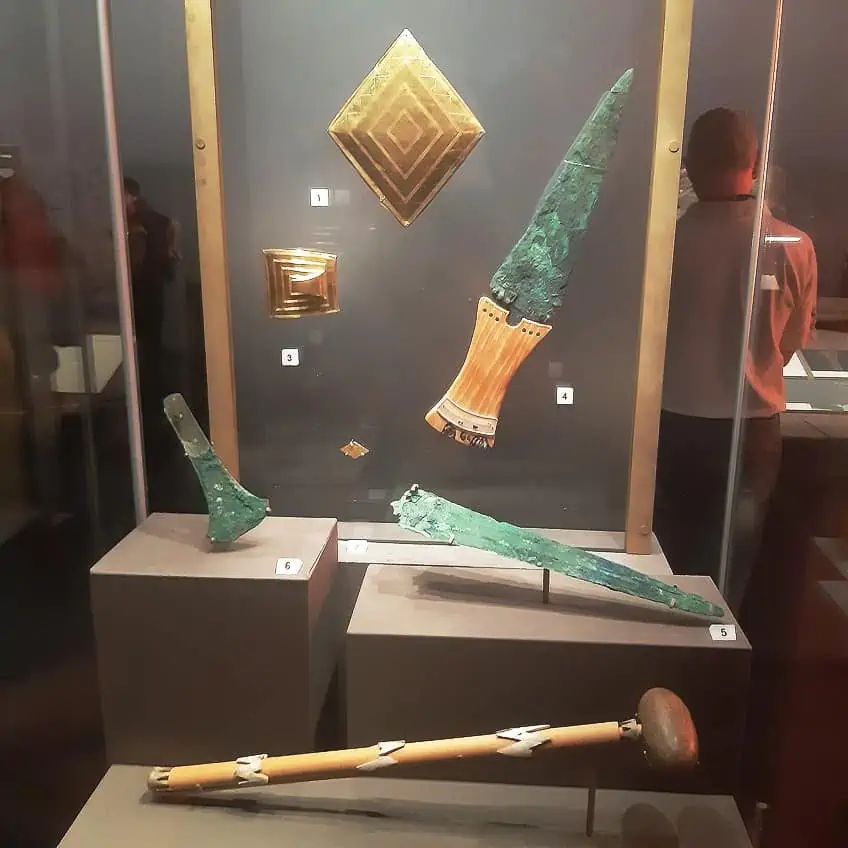
This precise process was then literally replicated tens of thousands of times. The handle of the dagger was then perforated with thousands of small holes, and a light coating of tree resin was smeared over the surface as glue to keep the golden studs in their place. Each golden stud was then delicately inserted into each tiny hole.
It has been calculated that the entire method – wire fabrication, stud fabrication, hole fabrication, resin gluing, and stud placing – would have taken approximately 2500 hours to execute.
The Antikythera Mechanism (c. 2nd century BCE)
| Date | c. 2nd Century BCE |
| Medium | Bronze |
| Artist | Unknown |
| Location | National Archaeological Museum, Athens |
The Antikythera mechanism appeared to be an unassuming clump of wood and bronze on an old shipwreck at first view. However, in 1902, one of the researchers who investigated wreckage from an 85 BC Greek ship spotted something unexpected. The artifact had broken open a little, revealing gear wheels inside. The Antikythera mechanism, sometimes regarded as the first computer, was an instrument used in astronomy.
Its two metal dials featured the horoscope and the periods of the year, with arrows showing the moon, sun, and the five planets that the Greeks were aware of in that era.
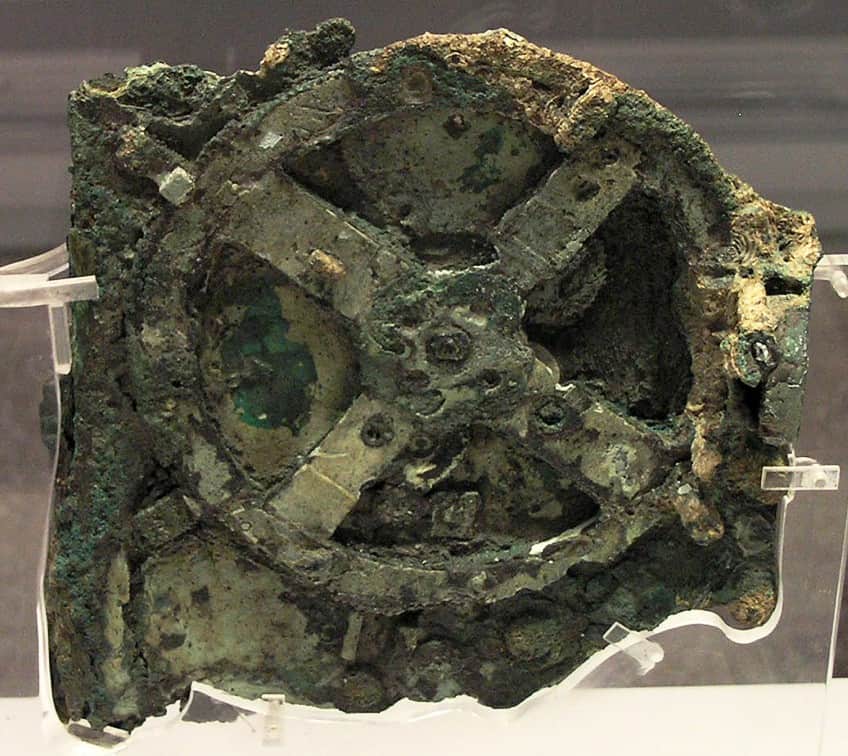
The Trundholm Sun Chariot (c.1,700 BCE)
| Date | c. 1,700 BCE |
| Medium | Bronze and gold |
| Artist | Unknown |
| Location | Sjælland, Denmark |
This gold and metal artifact was discovered in a swamp on the Danish island of Sjaelland in 1902. Although this artifact is supposed to date from the Nordic Bronze Age, its actual age is unknown. The artifact consists of a disc made of bronze with a thin film of gold hammered into one side, a bronze horse, and six wheels.
Aside from being a ceremonial device, it has been hypothesized that the chariot also served as a calendar.
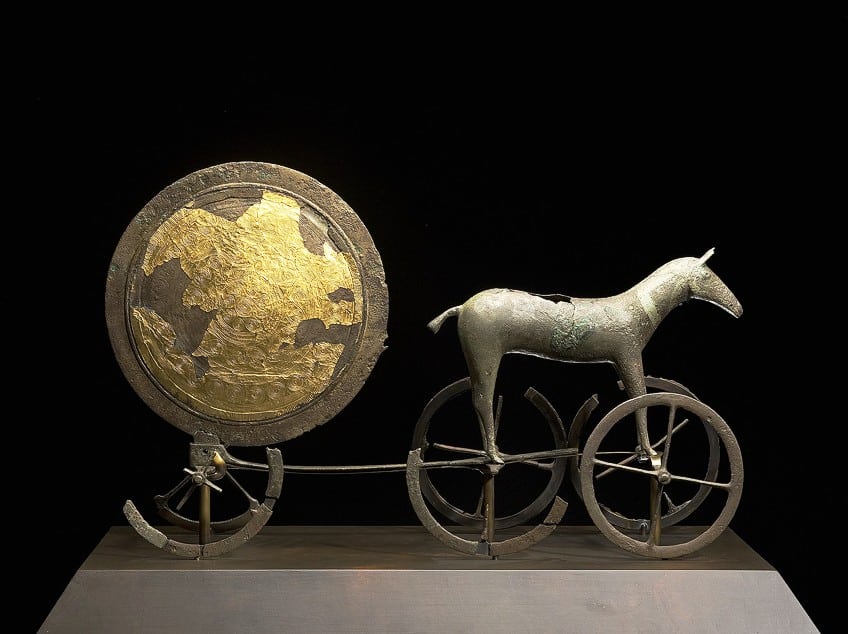
According to this hypothesis, the golden day-side of the big center inner circle has dimensions corresponding with one-third of a solar year, whereas the night-side has measurements connected with six lunar months. As a result, it was determined that the connection is to the moon’s motion on the night side at certain periods of the year and the sun’s motion on the day side of the Sun Chariot, which appears to be the correct calculation.
The Nebra Sky Disk (c. 1,600 BCE)
| Date | c. 1,600 BCE |
| Medium | Bronze |
| Artist | Unknown |
| Location | Saxony-Anhalt, Germany |
The Nebra Sky Disc is an ancient metal disc that is so unique that it was once thought to be an archaeological hoax. However, thorough scientific examination confirmed that it is, in fact, genuine. It had been ritualistically buried alongside two rare swords, axes, and a chisel made from bronze in an ancient sanctuary atop a hill.
The disc is embossed with gold symbols and has a green-blue patina. These are often viewed as a full moon or sun, a lunar arc, and stars. Later, two golden arcs were placed along the sides.

The two arcs accurately represent the angle between the summer and winter solstices at the Mittelberg latitude. An arc at the bottom, encircled by many strokes of unknown significance, has been alternately interpreted as the Milky Way or as a sun boat with multiple oars.
While earlier megalithic complexes such as Stonehenge were used to record the changing of the seasons, the disc is the world’s oldest “portable device” to enable such observations.
The Funerary Mask of King Tutankhamun (1323 BCE)
| Date | 1323 BCE |
| Medium | Gold, lapis lazuli, precious stones |
| Artist | Unknown |
| Location | Cairo, Egypt |
Tutankhamun was attractive yet frail, and he died when he was around 18 years old. Illustrations in his tomb depict a weak young monarch who knelt to hunt and relied on a crutch. During one of Egypt’s most tumultuous eras, he was the puppet king installed by the vizier Ay. Tutankhamun may have desired more authority as he grew into maturity.
A study of his corpse in 1968 found a laceration to the head, leading many to believe he was killed by Ay.
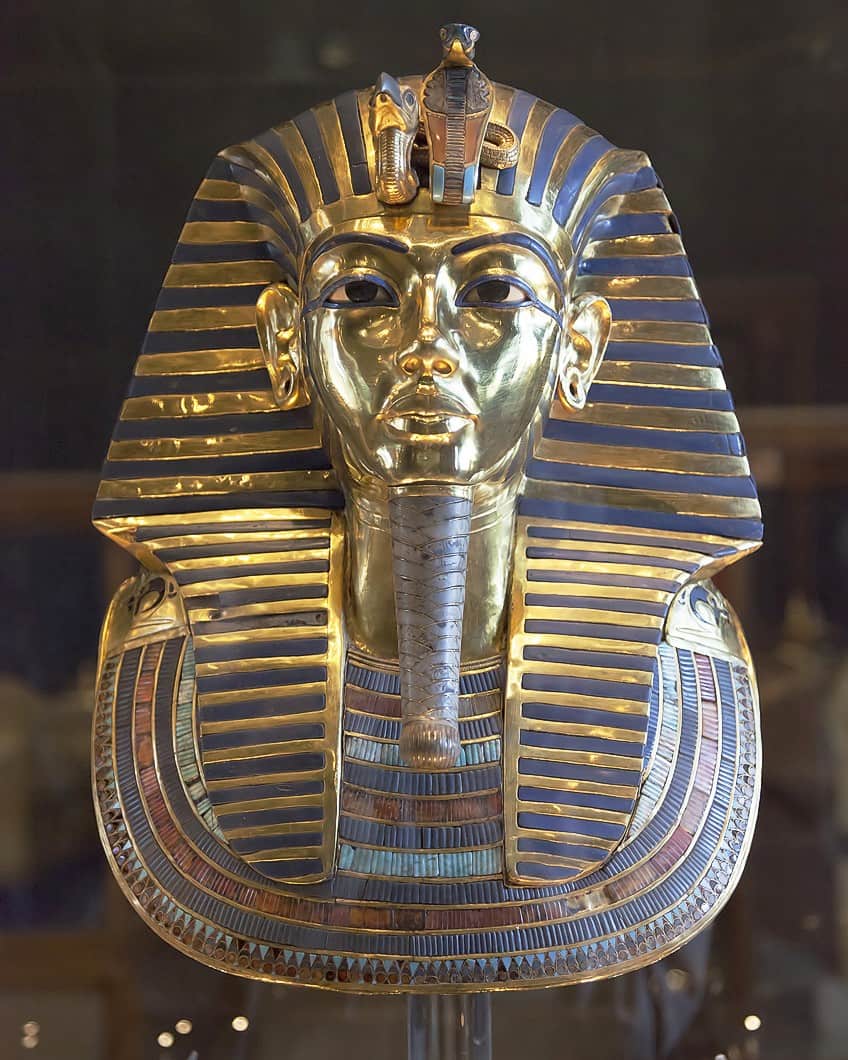
His grandiose burial might have therefore been part of a centuries-old cover-up. This portrait mask is both extraordinary and unique. It has the same symmetrical, uniform characteristics as earlier representations of Tutankhamun; it is an abstraction that conveys an aspect of the young king’s actual appearance.
Olmec Heads (c. 900 BCE)
| Date | c. 900 BCE |
| Medium | Basalt |
| Artist | Unknown |
| Location | Gulf Coast, Central America |
Sometime between 400 and 1,400 BC, the Olmec civilization sprang from the marshy woodlands of Mexico’s Gulf Coast. A farmer plowing the same area in 1862, discovered a giant stone head. It was the first of 17 such heads discovered, all of which were assumed to represent portraits of Olmec monarchs. They depict aristocratic-looking figures with flat noses, almond-shaped eyes, and thick lips.
However, each head has a distinct appearance, attitude, and headgear, lending credence to the theory that the carved stones resemble certain leaders.
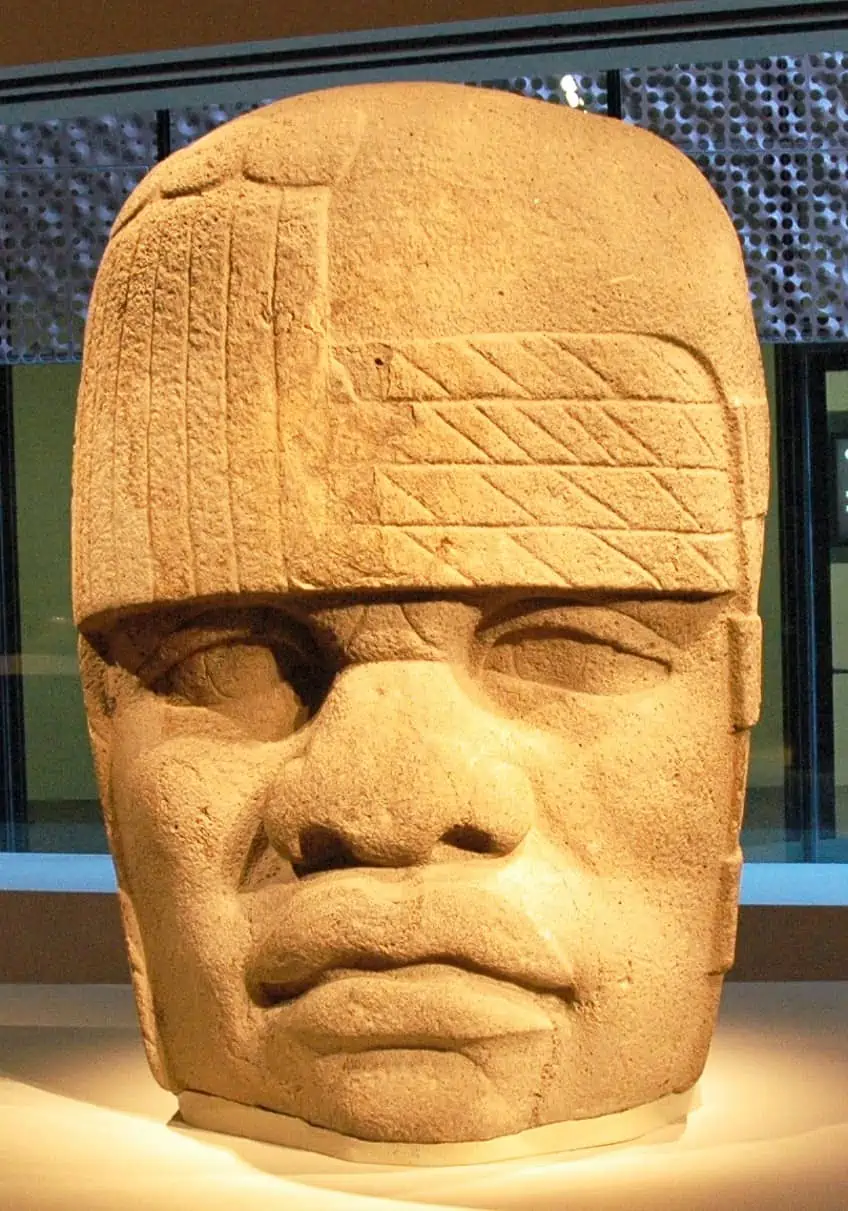
The first unintentional discovery happened in the Tuxtlas Mountains, which supplied the basalt stone required to create them. However, the majority of the heads were later discovered over 60 miles from the rock’s origin, in the ancient capitals of La Venta and San Lorenzo. Though no doubt difficult, it is unknown how the Olmec carried these gigantic rocks, which were finally cut and placed in prominent plazas.
Furthermore, numerous heads appear to have been smashed and buried a long time ago, leading some researchers to believe that ancient people purposefully destroyed old sculptures as new rulers acquired control.
Terracotta Baby Bottle and Rattle (400 BCE)
| Date | 400 BCE |
| Medium | Terracotta |
| Artist | Unknown |
| Location | Manduria, Italy |
Archaeologists in Italy discovered a 2,400-year-old ceramic baby’s bottle that served as a pig-shaped toy in 2013. The one-of-a-kind artifact was discovered in Manduria after building work revealed a Messapian tomb. The artifact is called a guttus, and it is a vase with a small opening or neck into which beverages were poured.
They were usually used to store wine and other beverages, but in this instance, the artifact was used to feed a newborn or small infant.
This guttus was styled to look like a pig, complete with pointed ears and it also has terracotta rattles in its stomach. The artifact dates back to 2,400 years, when a tribal society that came from Illyria around 1000 BC, lived in the southeast region of Italy. The Messapians disappeared after the Roman Republic captured and converted the region’s population.
Baghdad Battery (c. 250 BCE)
| Date | c. 250 BCE |
| Medium | Terracotta, copper sheet, bitumen, iron |
| Artist | Unknown |
| Location | National Museum of Irag, Iraq |
The Baghdad Batteries are a historical artifact discovered in 1936 in a town near Baghdad. Wilhelm König, a German archaeologist, spotted them at the Baghdad Museum two years later. He was astounded when he looked carefully. He went on to write a report claiming that they may have been electroplating batteries. A vertical iron rod was enclosed by a copper cylinder within the jars. The copper and iron were isolated from one another by an asphalt stopper.
If one filled them with an electrolyte, such as vinegar, a voltage differential between the iron and copper would be produced.
The Terracotta Army (248 BCE)
| Date | 248 BCE |
| Medium | Terracotta |
| Artist | Unknown |
| Location | Emperor Qinshihuang’s Mausoleum Site Museum, China |
The Chinese emperor, Qin Shihuang, required 700,000 laborers and more than 30 years to complete his tomb. The complex includes acrobat and dancer sculptures, gold-embellished chariots, and bronze birds in canals. The Terracotta Army, thousands of clay soldiers lining the ditches in tactical formation, is undoubtedly its most famous feature. Farmers excavating a well in 1974 unearthed the first statue. Since then, three large excavations have unearthed 2,000 more troops, and there are presumably another 6,000 still buried at the site.
Based on their distinctive attributes, each statue appears to depict an actual soldier in Qin Shihuang’s army.

The Rosetta Stone (196 BCE)
| Date | 196 BCE |
| Medium | Granodiorite |
| Artist | Unknown |
| Location | The British Museum, London |
In 1799, French forces seized a fort in Rosetta, Egypt, with just days to prepare for a clash with Ottoman Empire soldiers. The soldiers unearthed a big stone piece covered with three kinds of writing, which included ancient Greek while tearing down a wall made from the debris surrounding ancient Egyptian monuments. Bouchard was intrigued and wondered if the stone could convey the same message in three distinct languages. He informed French scientists who had gone to Egypt to look for ancient riches about his discovery.
The slab was known as the Rosetta Stone, and the characters and markings meticulously etched into its black surface would cast a new light on the ancient Egyptian civilization.
But first, academics would need to decipher its code and researchers rushed to decipher the Rosetta Stone. Though many experts from around Europe contributed to the effort, the two most significant contributions came from France and England. It comprises a proclamation confirming an Egyptian king’s royal cult. The Ptolemaic monarchy was at war and grappling with a domestic uprising at the time.

An assembly of priests passed the edict to praise the pharaoh and demonstrate their commitment to him. It was written in Demotic Egyptian writing, Ptolemaic hieroglyphics, and ancient Greek letters. Every temple in Egypt was to have an identical tablet.
The deciphering of the Rosetta Stone established the foundation of Egyptology, and the famous tablet is regarded as one of history’s most important artifacts.
However, the stone itself is contentious as a result of battle and imperial expansion. Was the Rosetta Stone brought to England, or was it stolen by the British? This depends on who you ask. There have been repeated appeals to restore the stone to Egypt throughout the years, but it has stayed in the British Museum, which receives over six million tourists each year.
The Dead Sea Scrolls (c. 1st century BCE)
| Date | c. 1st century BCE |
| Medium | Papyrus |
| Artist | Unknown |
| Location | Palestine |
In 1947, Bedouin youths were minding their flock in Qumran, an ancient hamlet on the northwest side of the Dead Sea. One of the teenage shepherds threw a rock into a cliff opening and was astonished to hear a crashing noise. After entering the cave, he and his fellow herders discovered several big clay jars, seven of which held papyrus texts. The collection was purchased by an antique merchant and eventually wound up in the hands of numerous researchers who estimated the writings to be over 2,000 years old.
Following the discovery, explorers and archaeologists discovered tens of thousands of more scroll fragments in ten neighboring caverns.

Scholars are still debating the origins of the Dead Sea Scrolls today. According to popular belief, they were created by a Jewish community that lived in Qumran until it was destroyed by Roman forces. Advocates of this theory point to parallels between the traditions detailed in the Community Rule – a scroll documenting the regulations of an unknown Jewish sect – and the account of Essene ceremonies provided by the Roman writer Flavius Josephus. The Dead Sea Scrolls contain portions from every chapter of the Old Testament.
The Copper Scroll, a type of archaic treasure map that identifies hundreds of silver and gold treasures, is one of the most interesting texts from Qumran.
The James Ossuary (c. 1st century AD)
| Date | c. 1st century AD |
| Medium | Limestone |
| Artist | Unknown |
| Location | Israel |
Some consider this artifact to be one of the most valuable Biblical relics of all time, as it contains the bones of Jesus’ supposed brother, and if proven true, would represent the very first tangible connection to Jesus. An Aramaic engraving on the burial casket reads, “James, the son of Joseph, and brother of Jesus.” The coffin was made from a single block of limestone, as was customary for Jewish burial coffins in first-century Palestine. Bodies were kept in caves for a year before the remains were retrieved and placed in a box in those days.
The ancient artifact has been at the center of some of the most contentious forgery cases in recent years.
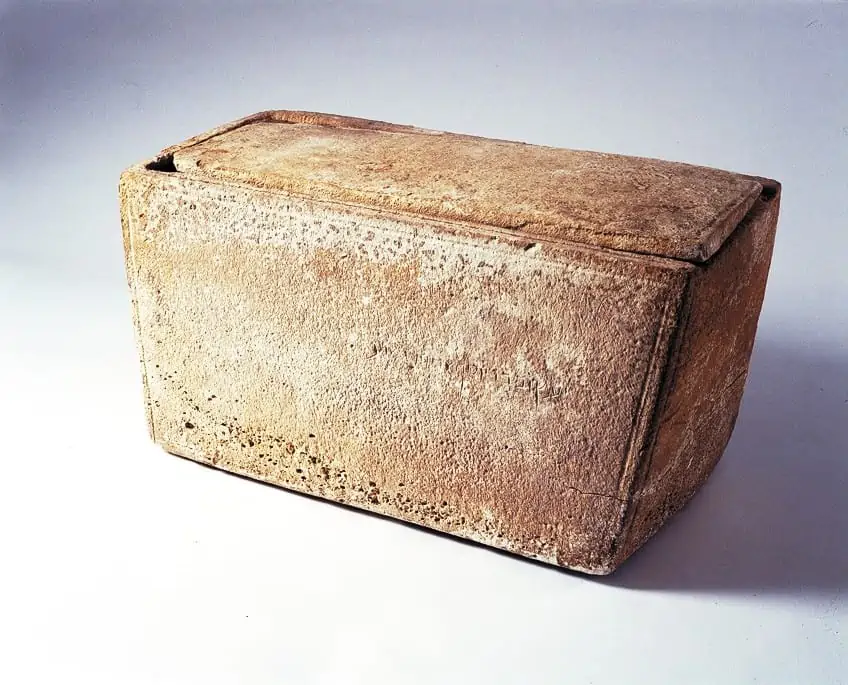
The Israel Antiquities Authority attempted to establish in court that the objects were faked by Oded Golan, an antique collector, however, their ruling was overturned and they attempted, unsuccessfully, to claim custody of the artifact. The box is also said to have been tampered with by the Israeli government before being handed back to its owner.
Lydenburg Heads (c. 500 AD)
| Date | c. 500 AD |
| Medium | Terracotta |
| Artist | Unknown |
| Location | Iziko South African Museum, Cape Town |
A young boy found unusual shards of pottery sticking out of a ravine near Lydenburg in South Africa, around 1963. Although the pieces were not properly excavated, the bulk of them was uncovered and reassembled to construct seven clay heads recognized as the Lydenburg Heads. The two biggest pieces may be used as masks and also incorporate animal figures.
This information, together with the existence of intricate necklaces, implies that the heads were most likely made for kings or the elite.

Thor’s Hammer (c. 900 AD)
| Date | c. 900 AD |
| Medium | Bronze |
| Artist | Unknown |
| Location | Købelev, Denmark |
The unearthing of a 10th-century Viking relic that resembles Thor’s Hammer has answered a long-standing puzzle regarding over 1,000 old amulets discovered across Northern Europe. The historical artifacts, referred to as the Mjöllnir amulets, seem to represent hammers, which have been attributed to the Norse deity Thor by historians. This could not be proven, however, because their designs were inconclusive and none of them bore inscriptions identifying their purpose. However, in 2014, a similar amulet was discovered near Kbelev, with the runic text “this is a hammer.”
The 1,100-year-old pendant, cast in bronze and possibly coated with tin, silver, and gold, demonstrates how Thor’s myth affected Viking jewelry.
Thor is a deity linked with lightning, storms, thunder, power, humanity’s protection, and fertility in Norse mythology. Thor is commonly referenced in the Germanic peoples’ history, from the period of the Roman occupation to the cultural advancements and tribal movements of the Migration Period, to the Viking Age when he was most renowned. Mjölnir amulets were worn in opposition to the Christianization of the region.
That concludes our exploration of famous ancient artifacts. These ancient world artifacts are all renowned for representing significant moments in human history and advancement. The famous artifacts from the ancient world can sometimes astound us with their level of technological advancement and scientific understanding. Historical artifacts can give us a glimpse at eras of the past and make us realize that perhaps we weren’t always the primitive species we thought we were. Yet, as much as has been discovered already, one can only guess how many hidden treasures of the past still lay buried beneath our feet.
Frequently Asked Questions
What Is the Oldest Human Artifact?
In all honesty, scientists are not sure who made the oldest artifact we have so far discovered. The Lomekwi Stone tools from Kenya were crafted around 3.3 million years ago, and modern humans as we know them today were not even around yet. However, there were other early hominins in the region that could be responsible for the tools such as Australopithecus. What we do know is that man-like beings have been making tools for far longer than we originally assumed.
What Is the Significance of Ancient World Artifacts?
There are large parts of our history as a species that are yet to be understood by historians, archeologists, and scientists. This is because there were not always written languages, and although many cultures have passed their knowledge on orally through tales and myths, many disappeared leaving only historical artifacts behind. These famous artifacts have allowed modern humans to gain a deeper understanding of the ancient cultures of the past. Without them, we would know practically nothing about prehistory.
Jordan Anthony is a Cape Town-based film photographer, curator, and arts writer. She holds a Bachelor of Art in Fine Arts from the University of the Witwatersrand, Johannesburg, where she explored themes like healing, identity, dreams, and intuitive creation in her Contemporary art practice. Jordan has collaborated with various local art institutions, including the KZNSA Gallery in Durban, the Turbine Art Fair, and the Wits Art Museum. Her photography focuses on abstract color manipulations, portraiture, candid shots, and urban landscapes. She’s intrigued by philosophy, memory, and esotericism, drawing inspiration from Surrealism, Fluxus, and ancient civilizations, as well as childhood influences and found objects. Jordan is working for artfilemagazine since 2022 and writes blog posts about art history and photography.
Learn more about Jordan Anthony and about us.
Cite this Article
Jordan, Anthony, “Famous Ancient Artifacts – Study Artifacts From the Ancient World.” artfilemagazine – Your Online Art Source. October 4, 2022. URL: https://artfilemagazine.com/famous-ancient-artifacts/
Anthony, J. (2022, 4 October). Famous Ancient Artifacts – Study Artifacts From the Ancient World. artfilemagazine – Your Online Art Source. https://artfilemagazine.com/famous-ancient-artifacts/
Anthony, Jordan. “Famous Ancient Artifacts – Study Artifacts From the Ancient World.” artfilemagazine – Your Online Art Source, October 4, 2022. https://artfilemagazine.com/famous-ancient-artifacts/.



